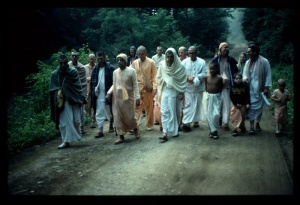CC Madhya 8.282: Difference between revisions
m (1 revision(s)) |
No edit summary |
||
| Line 1: | Line 1: | ||
{{ | [[Category:Sri Caitanya-caritamrta - Madhya-lila Chapter 08|C282]] | ||
<div style="float:left">'''[[Sri Caitanya-caritamrta|Śrī Caitanya-caritāmṛta]] - [[CC Madhya|Madhya-līlā]] - [[CC Madhya 8|Chapter 8: Talks Between Śrī Caitanya Mahāprabhu and Rāmānanda Rāya]]'''</div> | |||
<div style="float:right">[[File:Go-previous.png|link=CC Madhya 8.281|Madhya-līlā 8.281]] '''[[CC Madhya 8.281|Madhya-līlā 8.281]] - [[CC Madhya 8.283|Madhya-līlā 8.283]]''' [[File:Go-next.png|link=CC Madhya 8.283|Madhya-līlā 8.283]]</div> | |||
{{CompareVersions|CC|Madhya 8.282|CC 1975|CC 1996}} | |||
{{RandomImage}} | |||
==== TEXT 282 ==== | ==== TEXT 282 ==== | ||
<div | <div class="verse"> | ||
tabe hāsi’ tāṅre prabhu dekhāila svarūpa | :tabe hāsi’ tāṅre prabhu dekhāila svarūpa | ||
‘rasa-rāja’, ‘mahābhāva’—dui eka rūpa | :‘rasa-rāja’, ‘mahābhāva’—dui eka rūpa | ||
</div> | </div> | ||
| Line 12: | Line 16: | ||
==== SYNONYMS ==== | ==== SYNONYMS ==== | ||
<div | <div class="synonyms"> | ||
''tabe''—therefore; ''hāsi’''—smiling; ''tāṅre''—unto him (Rāmānanda Rāya); ''prabhu''—the Lord; ''dekhāila''—showed; ''svarūpa''—His personal form; ''rasa-rāja''—the king of all transcendental humors; ''mahā-bhāva''—the condition of ecstatic love; ''dui''—two; ''eka''—one; ''rūpa''—form. | |||
</div> | </div> | ||
| Line 19: | Line 23: | ||
==== TRANSLATION ==== | ==== TRANSLATION ==== | ||
<div | <div class="translation"> | ||
Lord Śrī Kṛṣṇa is the reservoir of all pleasure, and Śrīmatī Rādhārāṇī is the personification of ecstatic love of Godhead. These two forms had combined as one in Śrī Caitanya Mahāprabhu. This being the case, Lord Śrī Caitanya Mahāprabhu revealed His real form to Rāmānanda Rāya. | Lord Śrī Kṛṣṇa is the reservoir of all pleasure, and Śrīmatī Rādhārāṇī is the personification of ecstatic love of Godhead. These two forms had combined as one in Śrī Caitanya Mahāprabhu. This being the case, Lord Śrī Caitanya Mahāprabhu revealed His real form to Rāmānanda Rāya. | ||
</div> | </div> | ||
| Line 26: | Line 30: | ||
==== PURPORT ==== | ==== PURPORT ==== | ||
<div | <div class="purport"> | ||
This is described as rādhā-bhāva-dyuti-suvalitaṁ naumi kṛṣṇa-svarūpam. Lord Śrī Kṛṣṇa was absorbed in the features of Śrīmatī Rādhārāṇī. This was disclosed to Rāmānanda Rāya when he saw Lord Śrī Caitanya Mahāprabhu. An advanced devotee can understand śrī-kṛṣṇa-caitanya, rādhā-kṛṣṇa nahe anya. Śrī Caitanya Mahāprabhu, being a combination of Kṛṣṇa and Rādhā, is nondifferent from Rādhā-Kṛṣṇa combined. This is explained by Svarūpa Dāmodara Gosvāmī: | This is described as ''rādhā-bhāva-dyuti-suvalitaṁ naumi kṛṣṇa-svarūpam''. Lord Śrī Kṛṣṇa was absorbed in the features of Śrīmatī Rādhārāṇī. This was disclosed to Rāmānanda Rāya when he saw Lord Śrī Caitanya Mahāprabhu. An advanced devotee can understand śrī-kṛṣṇa-caitanya, ''rādhā-kṛṣṇa nahe anya''. Śrī Caitanya Mahāprabhu, being a combination of Kṛṣṇa and Rādhā, is nondifferent from Rādhā-Kṛṣṇa combined. This is explained by Svarūpa Dāmodara Gosvāmī: | ||
:rādhā kṛṣṇa-praṇaya-vikṛtir hlādinī śaktir asmād | :''rādhā kṛṣṇa-praṇaya-vikṛtir hlādinī śaktir asmād'' | ||
:ekātmānāv api bhuvi purā deha-bhedaṁ gatau tau | :''ekātmānāv api bhuvi purā deha-bhedaṁ gatau tau'' | ||
:caitanyākhyaṁ prakaṭam adhunā tad-dvayaṁ caikyam āptaṁ | :''caitanyākhyaṁ prakaṭam adhunā tad-dvayaṁ caikyam āptaṁ'' | ||
:rādhā-bhāva-dyuti-suvalitaṁ naumi kṛṣṇa-svarūpam | :''rādhā-bhāva-dyuti-suvalitaṁ naumi kṛṣṇa-svarūpam'' | ||
([[CC Adi 1.5]]) | :([[CC Adi 1.5]]) | ||
Rādhā-Kṛṣṇa is one. Rādhā-Kṛṣṇa is Kṛṣṇa and Kṛṣṇa’s pleasure potency combined. When Kṛṣṇa exhibits His pleasure potency, He appears to be two—Rādhā and Kṛṣṇa. Otherwise, Rādhā and Kṛṣṇa are one. This oneness may be perceived by advanced devotees through the grace of Śrī Caitanya Mahāprabhu. This was the case with Rāmānanda Rāya. One may aspire to attain such a position, but one should not try to imitate the mahā-bhāgavata. | Rādhā-Kṛṣṇa is one. Rādhā-Kṛṣṇa is Kṛṣṇa and Kṛṣṇa’s pleasure potency combined. When Kṛṣṇa exhibits His pleasure potency, He appears to be two—Rādhā and Kṛṣṇa. Otherwise, Rādhā and Kṛṣṇa are one. This oneness may be perceived by advanced devotees through the grace of Śrī Caitanya Mahāprabhu. This was the case with Rāmānanda Rāya. One may aspire to attain such a position, but one should not try to imitate the ''mahā-bhāgavata''. | ||
</div> | </div> | ||
__NOTOC__ | |||
<div style="float:right; clear:both;">[[File:Go-previous.png|link=CC Madhya 8.281|Madhya-līlā 8.281]] '''[[CC Madhya 8.281|Madhya-līlā 8.281]] - [[CC Madhya 8.283|Madhya-līlā 8.283]]''' [[File:Go-next.png|link=CC Madhya 8.283|Madhya-līlā 8.283]]</div> | |||
__NOTOC__ | |||
__NOEDITSECTION__ | |||
Revision as of 16:40, 20 August 2021

A.C. Bhaktivedanta Swami Prabhupada
TEXT 282
- tabe hāsi’ tāṅre prabhu dekhāila svarūpa
- ‘rasa-rāja’, ‘mahābhāva’—dui eka rūpa
SYNONYMS
tabe—therefore; hāsi’—smiling; tāṅre—unto him (Rāmānanda Rāya); prabhu—the Lord; dekhāila—showed; svarūpa—His personal form; rasa-rāja—the king of all transcendental humors; mahā-bhāva—the condition of ecstatic love; dui—two; eka—one; rūpa—form.
TRANSLATION
Lord Śrī Kṛṣṇa is the reservoir of all pleasure, and Śrīmatī Rādhārāṇī is the personification of ecstatic love of Godhead. These two forms had combined as one in Śrī Caitanya Mahāprabhu. This being the case, Lord Śrī Caitanya Mahāprabhu revealed His real form to Rāmānanda Rāya.
PURPORT
This is described as rādhā-bhāva-dyuti-suvalitaṁ naumi kṛṣṇa-svarūpam. Lord Śrī Kṛṣṇa was absorbed in the features of Śrīmatī Rādhārāṇī. This was disclosed to Rāmānanda Rāya when he saw Lord Śrī Caitanya Mahāprabhu. An advanced devotee can understand śrī-kṛṣṇa-caitanya, rādhā-kṛṣṇa nahe anya. Śrī Caitanya Mahāprabhu, being a combination of Kṛṣṇa and Rādhā, is nondifferent from Rādhā-Kṛṣṇa combined. This is explained by Svarūpa Dāmodara Gosvāmī:
- rādhā kṛṣṇa-praṇaya-vikṛtir hlādinī śaktir asmād
- ekātmānāv api bhuvi purā deha-bhedaṁ gatau tau
- caitanyākhyaṁ prakaṭam adhunā tad-dvayaṁ caikyam āptaṁ
- rādhā-bhāva-dyuti-suvalitaṁ naumi kṛṣṇa-svarūpam
- (CC Adi 1.5)
Rādhā-Kṛṣṇa is one. Rādhā-Kṛṣṇa is Kṛṣṇa and Kṛṣṇa’s pleasure potency combined. When Kṛṣṇa exhibits His pleasure potency, He appears to be two—Rādhā and Kṛṣṇa. Otherwise, Rādhā and Kṛṣṇa are one. This oneness may be perceived by advanced devotees through the grace of Śrī Caitanya Mahāprabhu. This was the case with Rāmānanda Rāya. One may aspire to attain such a position, but one should not try to imitate the mahā-bhāgavata.